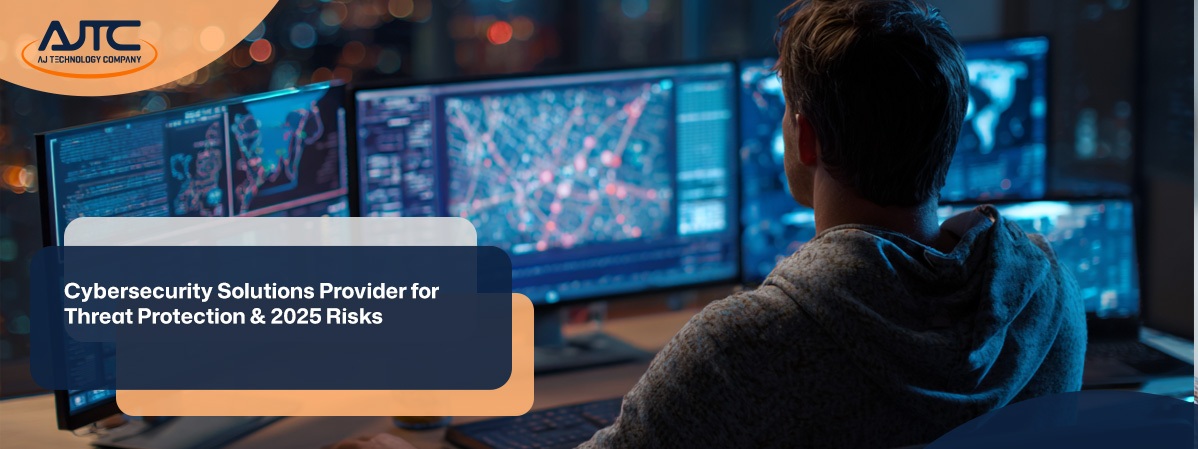.webp)
Chief Executive Officer

Businesses are facing more complex cyber threats than ever before. With the rise of remote work, cloud computing, and connected devices, the need for a reliable cybersecurity solutions provider has never been greater. In this blog, we’ll explore what makes a strong cybersecurity partner, the technologies that support modern protection, and how to choose the right provider. We’ll also cover endpoint security, detection and response strategies, and the importance of OT integration in 2024 and beyond.
A cybersecurity solutions provider plays a key role in protecting your business from digital threats. These providers offer a mix of services, tools, and expertise to help detect, prevent, and respond to cyberattacks. Whether you’re a small business or a growing enterprise, having the right partner can reduce risk and improve your overall security posture.
The best providers go beyond basic antivirus tools. They offer advanced threat detection, 24/7 monitoring, and tailored solutions that align with your business goals. Many also help with compliance requirements and provide training to reduce human error, which is often a major cause of breaches.

Cybersecurity platforms are the foundation of modern protection strategies. These platforms combine multiple tools and technologies into a unified system. Below, we break down the key components that make up a strong cybersecurity platform.
Threat protection involves identifying and blocking malicious activity before it causes harm. This includes real-time monitoring, intrusion prevention systems, and behavior-based detection. A well-designed threat protection strategy minimizes downtime and data loss.
Operational technology (OT) systems control physical processes in industries like manufacturing and energy. Securing these systems is critical because they often lack built-in security features. A cybersecurity solutions provider must understand how to protect OT environments without disrupting operations.
Sophos offers a range of cybersecurity tools, including firewalls, endpoint protection, and email security. It’s known for its user-friendly interface and strong integration across products. Businesses that use Sophos often see improved threat visibility and faster response times.
Fortinet provides a broad suite of security tools that work together through its Security Fabric. This integration allows for centralized management and better coordination between systems. It’s especially useful for organizations with complex networks.
Advanced threats are sophisticated attacks that bypass traditional defenses. These include zero-day exploits and targeted phishing campaigns. A strong cybersecurity platform uses AI and machine learning to detect unusual patterns and respond quickly.
Cyber threats are evolving, and businesses must be ready for what’s coming in 2025. This means investing in scalable solutions, training staff, and staying informed about new attack methods. A forward-thinking cybersecurity solutions provider will help you plan for the future.
Modern businesses operate across multiple environments—cloud, on-premises, and hybrid. Managing cyber threats across all these areas requires consistent policies and centralized visibility. A unified platform simplifies this process.

Top cybersecurity providers don’t just sell tools—they deliver complete solutions and services. This includes consulting, implementation, and ongoing support. By focusing on outcomes rather than products, these providers help businesses achieve real security improvements.
A cybersecurity solutions provider that offers both services and solutions can adapt to your changing needs. Whether you’re expanding to new locations or adopting new technologies, they ensure your security strategy stays aligned.
Every business has unique risks and requirements. Cybersecurity services are designed to meet those specific needs through customized assessments, policies, and controls. Below, we explore how these services are tailored to different areas of your organization.
Ransomware attacks can lock you out of your systems and demand payment to restore access. Cybersecurity services help by implementing backup solutions, email filtering, and endpoint protection to reduce the risk.
Remote work introduces new vulnerabilities. Services like secure VPNs, multi-factor authentication, and mobile device management help protect remote employees from cyberattacks.
Critical infrastructure, such as power grids and water systems, must remain operational at all times. Cybersecurity services for these sectors focus on availability, integrity, and compliance with industry standards.
Barracuda Networks offers tools that protect against phishing, spam, and malware. Their solutions are especially useful for businesses that rely heavily on email communication.
The Gartner Magic Quadrant evaluates vendors based on their ability to execute and completeness of vision. Choosing a cybersecurity solutions provider recognized in the Magic Quadrant can give you confidence in their capabilities.
Being aligned with a leader in the 2025 Gartner report means your provider is ahead of the curve. These leaders often offer the most innovative and reliable technology security solutions.

Implementing cybersecurity solutions starts with a risk assessment. This helps identify your most valuable assets and the threats they face. From there, your provider can recommend tools and policies that match your risk level and budget.
Training is also a key part of implementation. Employees need to understand how to recognize threats and follow security best practices. Ongoing monitoring and regular updates ensure your defenses stay strong over time.
Choosing the right cybersecurity solutions provider is a critical decision. Here are some best practices to guide your selection process:
A strong partner will not only protect your business but also help it grow securely.

Are you a business with over 10 employees looking for a cybersecurity solutions provider that understands your needs? Our team works with growing companies to build strong defenses, reduce risk, and ensure compliance. We tailor our services to your size, industry, and goals.
At AJTC, we offer a full range of cyberspace security solutions and technology security solutions. From endpoint protection to managed detection and response, we help you stay ahead of threats. Contact us today to learn how we can support your business.
Cybersecurity refers to the overall practice of protecting systems, networks, and data. A cybersecurity solution is a specific tool or service used to achieve that protection. For example, antivirus software is a solution within the broader field of cybersecurity. Businesses often need a mix of solutions to create a complete defense strategy.
When selecting a cybersecurity solutions provider, make sure they offer both strategic planning and hands-on tools. This ensures your business is covered from all angles, including endpoint protection and detection and response.
Cyber risk affects businesses of all sizes, but small and medium businesses often lack the resources to recover quickly. A single cyberattack can lead to data loss, downtime, and financial penalties. That’s why it’s important to work with a cyber security services company that understands your specific needs.
By using cyberspace security solutions and planning for 2025 threats, you can reduce your exposure. Look for providers that offer scalable services and integration with your existing systems.
Operational technology (OT) systems control machinery and production lines. If these systems are compromised, it can halt operations and impact safety. OT security focuses on protecting these environments from cyber threats.
A cybersecurity solutions provider with OT experience can help you secure these systems without disrupting production. They may also offer technology security solutions that align with industry regulations and 2024 compliance standards.
A cybersecurity platform combines multiple tools into one system. This makes it easier to manage security across your entire organization. Instead of juggling separate tools, you get centralized visibility and control.
Platforms often include features like threat detection, endpoint management, and integration with cloud services. This helps businesses respond faster to threats and maintain consistent protection.
Sophos is known for its ease of use and strong endpoint protection. Fortinet offers a wide range of tools with deep integration capabilities. Both are strong options, depending on your business needs.
When choosing between them, consider your current infrastructure and future goals. A cybersecurity solutions provider can help you evaluate which system fits best with your existing tools and long-term plans.
The Gartner Magic Quadrant helps businesses compare vendors based on performance and vision. Providers in the “Leaders” quadrant are often the most reliable and innovative.
If you're evaluating a cybersecurity solutions provider, check if they appear in the 2025 Magic Quadrant. This can give you confidence in their ability to handle advanced threats and deliver long-term value.